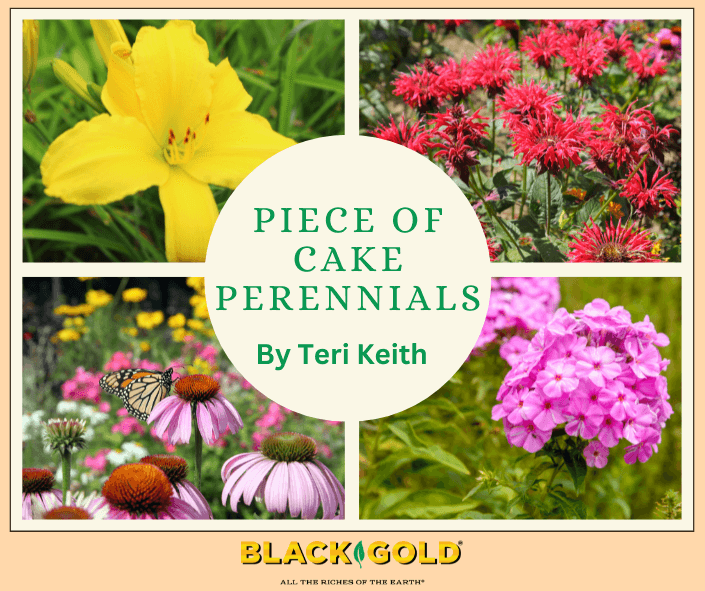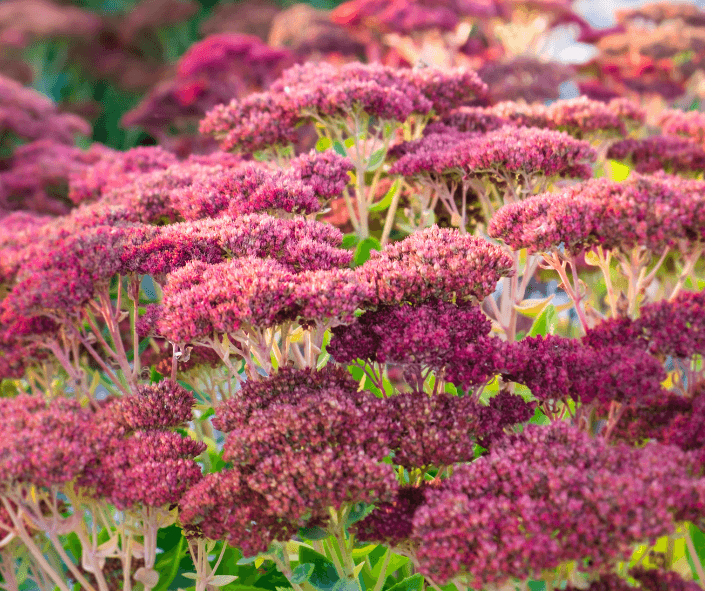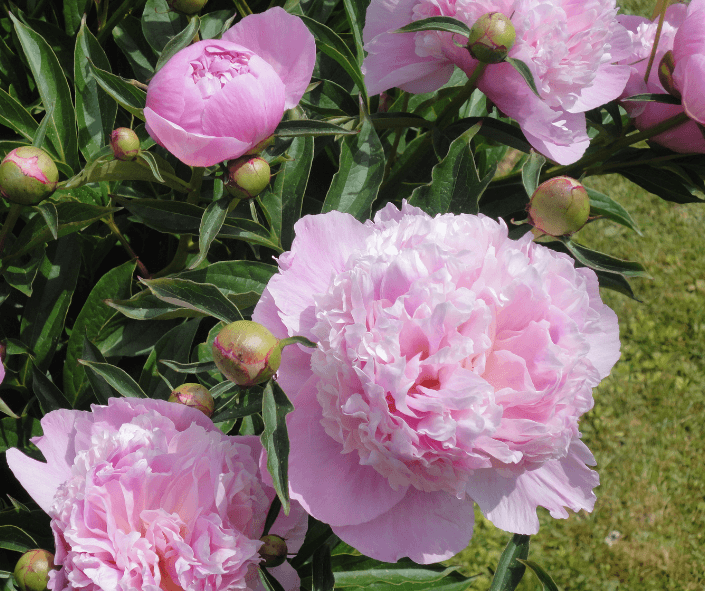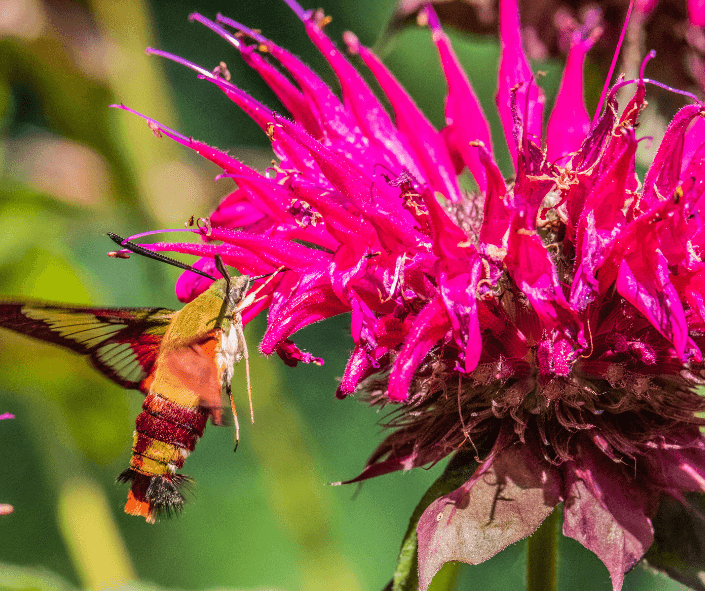
Perennials are the floral backbone of my garden because they develop over time and last. I look for exciting new ones each year. Whenever a newly introduced perennial exceeds expectations and gets rave reviews, the plant will almost certainly find itself included on my spring shopping list.
I shared my favorites with customers when I managed the perennial section of a local nursery in Bloomington, Indiana. Now I can share them with Black Gold readers! I tend to like both easy and beautiful perennials with a long season of garden interest. All of the plants mentioned are pollinator favorites!
Piece of Cake Perennials

Daylilies (Hemerocallis hybrids, USDA Hardiness Zones 4-9, ) are notoriously hard to kill. That is why you can often find old-fashioned forms, like lemon lilies (Hemerocallis flava), blooming in vacant residential properties years after anyone has been around to feed or water them. Rebloomers and specialty varieties in vibrant shades of red, yellow, orange, pink, and purple. Some are very tall, such as the late-blooming ‘Autumn Minaret’ (5.5 feet), while others are compact, like the 12-15 inch ‘Little Grapette‘. Favorites with specialty blooms are ‘Diva’s Choice’, with bright, deep pink petals, and heavily ruffled yellow edges, and ‘Pansy Face Charmer’, yellow with dark purple edges that look like pansies.
Because of their ease of growth, daylilies are ideal plants for novice gardeners. Plant daylilies in full to partial sun in the mid-spring. They like average to fertile soil with good drainage. Bloom time varies, but most flower in the early summer. Rebloomers can continue to flower intermittently into fall with good care.
Tall phlox (Phlox paniculata, Zones 4-8) is a pretty, long-flowering perennial native to the eastern U.S. Height varies, depending on the variety, but they tend to reach between 2 and 4 feet tall. Cultivated forms have flowers that range in color from white, red, pink, and purple. Look for the vibrant-fuchsia-flowered ‘Material Girl’ (3 feet), coral-pink-flowered ‘Sunset Coral‘ (2.5 feet), and pink-flowered ‘Jeana‘ (4 feet) with its large panicles of small flowers known to attract pollinators in high quantities.
Grow tall phlox in the full to partial sun and fertile soil amended with Black Gold Natural & Organic Garden Compost Blend. With care, they can bloom for a month or two from mid- to late-summer.

Tall and creeping hardy sedums (Sedum species and hybrids) comprise hundreds of hardy species of creeping, and mound-shaped plants, with thick, oval, succulent leaves. The popular tall, fall-flowering ‘Autumn Fire’ (18-24 inches) has brilliant pink blooms. The even taller ‘Thunderhead’ (30″) is an all-round beauty with its deep purple leaves and glorious rosy-purple fall flowers. Good low-growing forms for foliar and floral appeal include Proven Winner’s rose-flowered Rock ‘N Round® ‘Superstar’ (12 x 20 inches)and the spreading, fully evergreen, golden-leaved ‘Angelina‘ (Zones 5-9) with yellow flowers in early summer.
Give plants sharply drained soil with average to good fertility. They are almost exclusively sun-loving and drought-resistant, save for rare exceptions like the eastern US native, two-row stonecrop (Sedum ternatum). Flowering time varies from summer to fall, depending on the type.

Purple Coneflower (Echinacea purpurea and hybrids, Zones 3-9) are easy to grow, loved by pollinators, and their seeds feed songbirds. The popular purple coneflower is a member of the sunflower family native to eastern North America and adapted for life on open prairies. Established plants are hardy, drought-tolerant, and notably hard to kill as long as they are planted in a good location. Give them full sun, average to organic-rich soil and they will bloom from June to July. Some varieties will even flower into August.
One of the best classic varieties available is the vigorous, large-flower ‘Magnus‘ ( 3-4 feet) with its extra bright purple-pink flowers. According to an Echinacea trail at the Mount Cuba Center the red-flowered hybrid Lakota™ Santa Fe Coneflower, the raspberry-pink flowered KISMET® Raspberry, and the compact, warm coral-pink flowered SOMBRERO® Poco Hot Coral were some of the very best performers in northern Delaware’s hot summer weather.

Hostas (Hosta species and hybrids, Zones 3-8) are a spectacular group of perennials that hail from eastern China and Japan. They are prized for their ornamental foliage and regarded as shade-garden superstars. There are is no shortage of varieties and aficionados. Presently there are more than 3,000 varieties in existence and plenty of collectors and enthusiasts! The best source for additional information is the American Hosta Society. The sturdy plants can either be very large or miniature and flower only briefly, in either spring, summer, or early fall, depending on the variety. Some of my favorites are the gold and green ‘Glad Rags’, gigantic blue-green-leaved ‘Blue Angel’, variegated, wavy-leaved ‘Fire and ‘Ice’, and very large, infallible ‘Sum and Substance’ with its waxy, chartreuse leaves. Grow them all in fertile soil with plenty of organic matter.

Common peonies (Paeonia lactiflora, Zones 3-8) (an old-fashioned flower pronounced “piony” by my grandparents’) are elegant spring-flowering plants native to central and eastern Asia. The large, late-spring bloomers have large single or double blooms that run the gamut from white to pink and red. Peonies are noteworthy for the sweet-sap-seeking ants that visit their globose flower buds. The ants do not harm the plants, so my advice is to leave the insects alone. Double-flowered varieties tend to have heavy blooms that flop in the rain, so many gardeners cage the bushy plants to better support the weighty flowers (click here to learn more). Full to partial sun is the preferred light and well-drained loamy soil is the preferred ground. The best time to plant them is in early spring or fall.

Beebalms (Monarda hybrids) are another group of plants native to North America and members of the mint family. The two most common garden spaces are Oswego tea (Monarda didyma, Zones 4-9), with its scarlet-red flowers collared by red-tinged bracts, and common beebalm (Monarda fistulosa, Zones 3-8), which features light lavender to pinkish-white flowers surrounded by green bracts often tinted with pink. Both plants are hummingbird favorites!
Monarda hybrids are common and numerous and are in shades of lavender, white, pink, and red. A common problem is powdery mildew, a foliar disease causing powdery white spots. Numerous resistant varieties are available, including ‘Red Velvet’ with its cherry-red flowers and bronzy foliage, and the compact ‘Leading Lady Razzberry’. Give the plants well-drained soil and full sun. Flowering occurs in the summer.
Perennials are very satisfying flowers. They bloom every year, and I always find room to plant new ones. When small plants arrive from catalogs or online nurseries, I always pot them up using Black Gold® All Purpose Potting Soil to let them grow larger before I put them in the ground. When they are large enough to plant in the ground in late spring, I amend the soil with Black Gold Natural & Organic Garden Compost Blend. Two of my favorite online perennial sources are Bluestone Perennials and Roots and Rhizomes.

